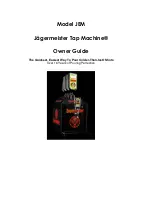
EQUIPMENT INSTALLATION continued
Salt Line Connection
The salt line from the brine tube connects to the valve. Make
certain the connections are hand tightened. Be sure that the
salt line is secure and free from air leaks. Even a small leak
may cause the salt line to drain out, and the softener will not
draw salt from the tank. This may also introduce air into the
valve causing problems with valve operation.
Brine Tube
Salt Line Connection
Figure 14 Salt Tank Check Valve and Brine Well Assembly
Electrical Connection
CAUTION
This valve and control are for dry location use
only unless used with a Listed Class 2 power
supply suitable for outdoor use.
All 706 Series controllers operate on 12-volt alternating current
power supply. This requires use of the proper supplied AC
adapter included with your system.
AC Adapters:
Make sure power source matches the rating printed on the AC
adapter.
NOTE: The power source should be constant. Be certain
the AC adapter is not on a switched outlet. Power
interruptions longer than 8 hours may cause the
controller to lose the time setting. When power is
restored, the time setting must then be re-entered.
SYSTEM DISINFECTION
Disinfection Of Water Softeners
The materials of construction of the modern water softener
will not support bacterial growth, nor will these materials
contaminate a water supply. During normal use, a softener
may become fouled with organic matter, or in some cases with
bacteria from the water supply. This may result in an off-taste
or odor in the water.
Some softeners may need to be disinfected after installation
and some softeners will require periodic disinfection during
their normal life.
Depending upon the conditions of use, the style of softener, the
type of ion exchanger, and the disinfectant available, a choice
can be made among the following methods.
Sodium or Calcium Hypochlorite
Application
These materials are satisfactory for use with polystyrene
resins, synthetic gel zeolite, greensand and bentonites.
5.25% Sodium Hypochlorite
These solutions are available under trade names such as
Clorox*. If stronger solutions are used, such as those sold for
commercial laundries, adjust the dosage accordingly.
1. Dosage
A. Polystyrene resin; 1.2 fl uid ounce per cubic foot (35.5 ml
per 0.03 cubic meter).
B. Non-resinous exchangers; 0.8 fl uid ounce per cubic foot
(23.7 ml per 0.03 cubic meter).
2. Salt tank softeners
A. Backwash the softener and add the required amount of
hypochlorite solution to the well of the salt tank. The salt
tank should have water in it to permit the solution to be
carried into the softener.
B. Proceed with the normal recharge.
*Clorox is a trademark of the Clorox Company.
Calcium Hypochlorite
Calcium hypochlorite, 70% available chlorine, is available
in several forms including tablets and granules. These solid
materials may be used directly without dissolving before use.
1. Dosage
A. Two grains, approximately 0.1 ounce per cubic foot
(3 ml per 0.03 cubic meter).
2. Salt tank softeners
A. Backwash the softener and add the required amount
of hypochlorite to the well of the salt tank. The salt tank
should have water in it to permit the chlorine solution to
be carried into the softener.
B. Proceed with the normal recharge.
OM26KCS, OM32KCS, OM36KCS, OM40KCS JA13 • 9










































